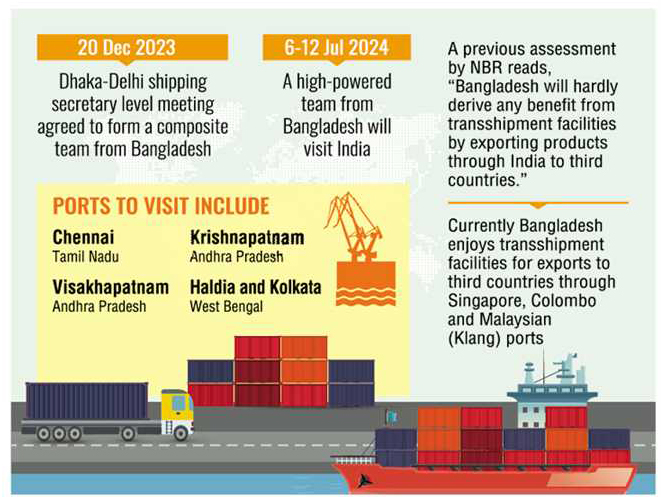
Exports to third countries
Use of Indian ports under consideration
REZAUL KARIM | Wednesday, 3 July 2024
Bangladesh is set to make feasibility check on potential Indian ports for rerouting exports to third countries in a change of traditional entrepots, with bilateral connectivity moves now getting in high gear.
A high-powered team will visit India between 06 and 12 July to ascertain technical feasibility and commercial viability of shipping cargo to a third country or destination under provisions of the Coastal Shipping Agreement and Protocol on Inland Water Transit and Trade (PIWT&T).
Shipping secretary-level talks between Dhaka and New Delhi on 20 December 2023 agreed to form a composite team from Bangladesh with such end in view.
The 16-member team is due to visit some ports of Chennai in Tamil Nadu, Visakhapatnam and Krishnapatnam in Andhra Pradesh, and Haldia and Kolkata in West Bengal.
Currently, Bangladesh takes transhipment facilities by exporting its products to third countries through Singapore, Colombo and Malaysian (Klang) ports.

SM Mostafa Kamal, joint secretary of shipping ministry, will lead the feasibility team.
Asked about their mission, Mr Kamal said, "We'll visit some ports of the eastern coast of India from July 06 to 12. Later, we'll sit with stakeholders concerned for opinion sharing."
They plan to prepare a comprehensive feasibility report through scrutinising and compiling relevant issues for submission to the government.
However, a previous assessment by the National Board of Revenue (NBR) reads: "Bangladesh will hardly derive any benefit from transshipment facilities by exporting its products through India to third countries."
The NBR put forward the views in response to a request by commerce ministry, which was scrutinising the pros and cons of the facility India announced recently.
Sources here have said India has widened the facility by including riverine routes with the surface communications systems, but it is unlikely to bode well for local exporters for loading-unloading hassles as well as time-consuming processes.
They are of the view that the transshipment facility, as announced, would not be viable for Bangladesh as the Chattogram and Mongla seaports do have similar facilities for exporting Bangladeshi products to different countries.
Earlier in 2018, India had given the facilities to carry containerised cargoes by road and rail, and utilise their specified Land Customs Stations (LCSs), seaports and airports, to export goods to third countries.
Senior officials of the commerce ministry explain that some strategic issues, including the country's security, are involved with such transshipment.
Besides, these types of facilities offered by any country or economic bloc take time for detailed scrutiny to see if these would be beneficial options for the country.
According to a Bangladesh-India joint statement issued on 07 September 2022, after conclusion of the bilateral meeting during the PM's visit, the Indian side invited Bangladesh business community to use its port infrastructures for transshipment of export cargoes.
India has also been providing free transit to Bangladesh for exporting its products to Nepal and Bhutan.
The Indian Central Board of Indirect Taxes & Customs (CBIC) amended its previous circular, issued in 2018, incorporating the extended facilities, and issued a fresh circular regarding the amendment on September 14, 2022.
The NBR, however, viewed in favour of the transshipment facilities through the LCSs of Banglabandha, Chilahati, Burimari and Sonahat by truck, rail and covered van, and the LCSs of Chilmari river port and Dhubri-Nunkhawa by river routes.
The revenue board also pointed out that there was no mention about the fees and charges for facilitating transshipment in the Indian circular.
"The bond-submission provision is not logical in the context of international practices as the bond may be equal to applicable duty in accordance with the invoice of goods concerned," it said.
The section 3.3 of the circular states: "he authorized carrier shall also enter into a transshipment bond with the commissioner of customs (prev.), West Bengal, in the form and manner prescribed by the said commissioner. The bond shall be of an amount equivalent to twice the value of goods to be transshipped."
And the section 3.1 of the circular reads: "With a view to facilitating and leveraging the potential of inland waterways for enhancing trade and transit, it has decided to allow the transshipment of containerized export goods of Bangladesh through India using riverine and rail routes."
The sub-section of the circular provides that the first leg involves entry of containerized cargo into India through LCS Hemnagar, from where the goods will be transported to the seaport of Kolkata or Haldia on a barge/vessel using the riverine route agreed under the protocol on Inland Water Transit and Trade between Indian and Bangladesh route.
According to the sub-section B, the second leg involves the unloading of containers from the barge/vessel and further loading on a railway train at the seaport of Kolkata or Haldia, from where goods will travel by rail to the seaport of Nihav Sheva or Mundra for exporting to the third countries.
rezamumu@gmail.com